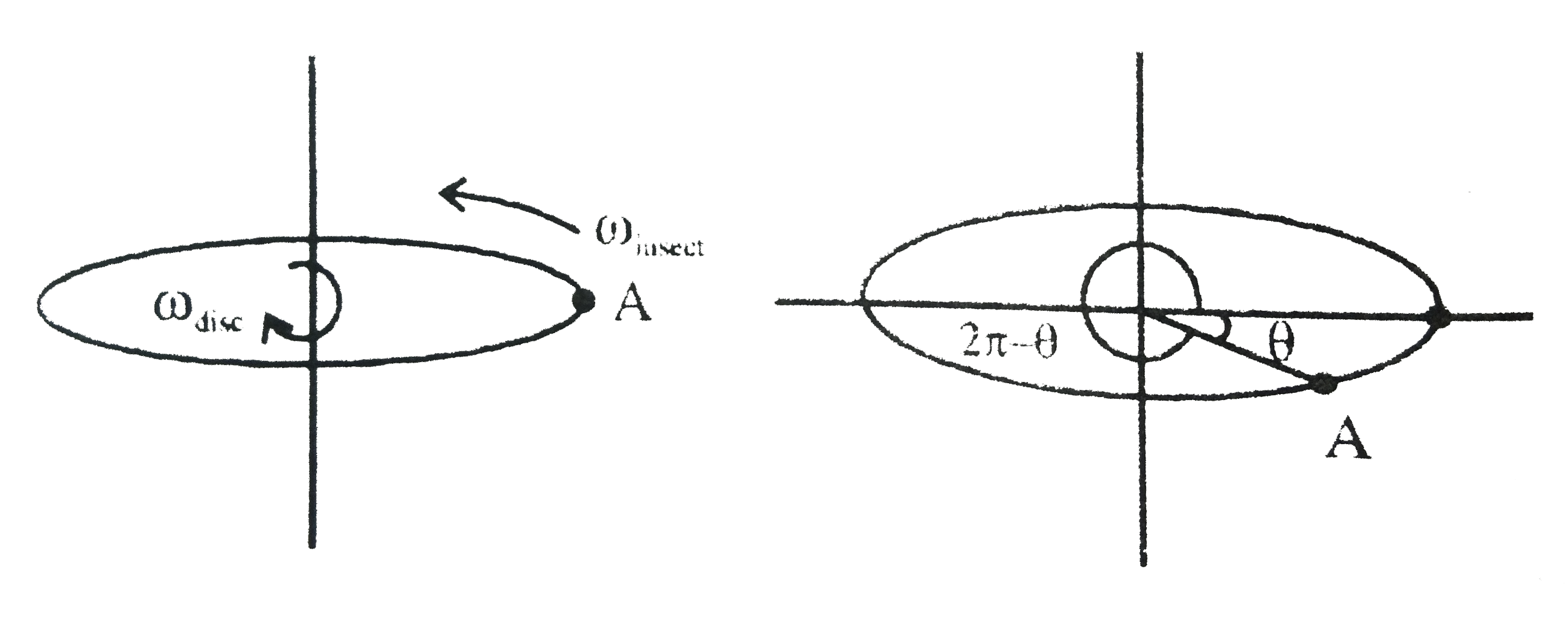A circular disc of mass 300gm and radius 20cm can roate freely about a vertical axis passing through its centre of O.A small inset of mass 100gm is initially stationary) the insect starts walking from rest along the rim of the disc with such a time varying relative velocity that the disc rotates in the opposite direction with a constant angular acceleration =2πrad/s2. After some time T, the insect is back at the point A. By what angle has the disc rotated till now , as seen by a stationary earth observer ? Also find the time T.
The correct Answer is:t=2/√5sec,θ=4π/5rad.
From conservation of angular momentum

Idiscωdisc=Iinsectωinsect⇒Idiscαdisc=Iinsectαinsect
12×(0.3)×(0.2)2×2π=(0.1)×(2)2×αinsect
αinsect=3πrad/sec2
Angular covered by disc =θ,
so angle covered by insect =2π−θ
For disc θ=12αdiscT2
θ=12×2πT2⇒T2=θ/π
For insect 2π−θ=12α∈sectT2
From equation (1) and (2)
2π−θ=12×3π×θπ⇒2π−θ=3θ2
θ=4π5rad.
Similar Questions
A horizontal disc is rotating about a vertical axis passing through its centre. If an insect moves from centre to rim then the angular momentum of the system
View SolutionA horizontal disc is rotating about a vertical axis passing through its centre. If an insect moves from centre to rim then the angular momentum of the system
View Solution
Knowledge Check
- Question 1 - Select One
A uniform disk of mass 300kg is rotating freely about a vertical axis through its centre with constant angular velocity ω. A boy of mass 30kg starts from the centre and moves along a radius to the edge of the disk. The angular velocity of the disk now is
Aw06Bw05C4ω05D5ω06 - Question 2 - Select One
A thin horizontal circular disc is rotating about a vertical axis passing through its centre. An insect is at rest at a point near the rim of the disc. The insect now moves along a diameter of the disc to reach other end. During the journey of the insect, the angular speed of the disc
Aremains unchanged.Bcontinuously decreases.Ccontinuously increases.Dfirst increases and then decreases. - Question 3 - Select One
A thin horizontal circular disc is roating about a vertical axis passing through its centre. An insect is at rest at a point near the rim of the disc. The insect now moves along a diameter of the disc to reach its other end. During the journey of the insect, the angular speed of the disc.
Acontinuously decreasesBcomtinuously increasesCfirst increases and then decreasesDremains unchanged
A horizontal disc is rotating about a vertical axis passing through its centre. If an insect moves from centre to rim then the angular momentum of the system
View SolutionA disc, initially at rest, starts rotating about its own axis/ with a constant angular acceleration of 0*2 rad/s2. The time taken by the disc to rotate by 10 rad (in seconds) is
View SolutionA thin horizontal circular disc is roating about a vertical axis passing through its centre. An insect is at rest at a point near the rim of the disc. The insect now moves along a diameter of the disc to reach its other end. During the journey of the insect, the angular speed of the disc.
View SolutionA uniform disc of mass m and radius R rotates about a fixed vertical axis passing through its centre with angular velocity ω. A particle of same mass m and having velocity of 2ωR towards centre of the disc collides with the disc moving horizontally and sticks to its rim. Then
View SolutionA horizontal disc rotates freely about a vertical axis through its centre. A ring, having the same mass and radius as the disc, is now gently placed on the disc. After some time, the two rotate with a common angular velocity, then
View Solution
